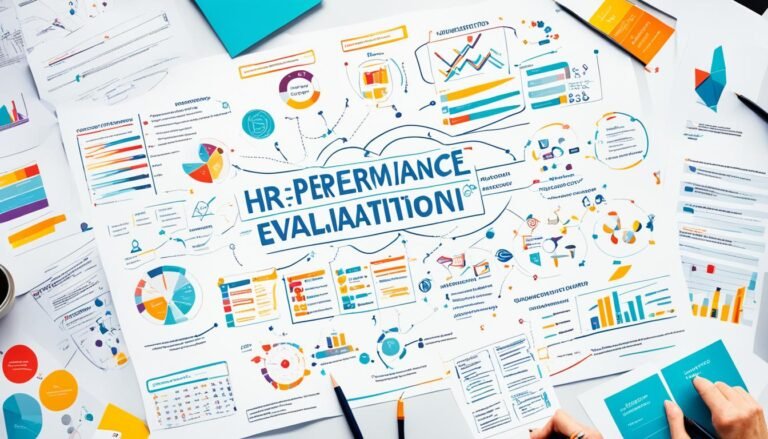Understanding Employee Relations and Its Role in Human Resources
Exploring the intricate interplay of employee relations within the domain of human resources can be both enlightening and essential.
As you navigate through the maze of workplace dynamics, uncovering the nuances of fostering fruitful interactions among employees may hold the key to organizational harmony and productivity.
Understanding the multifaceted facets of employee relations not only shapes the core culture of a company but also influences its overall performance and success.
Stay tuned to unravel the intricate web of employee relations and its profound impact on the modern workplace.
Key Takeaways
- Employee relations fosters a positive work environment and boosts productivity.
- Trust and communication are vital for building strong relationships in the workplace.
- Conflict resolution strategies are essential to maintain a harmonious work environment.
- Legal compliance and ethics ensure fair treatment and ethical standards for all employees.
Importance of Employee Relations
Understanding the significance of employee relations is important for fostering a positive work environment and enhancing organizational productivity. Employee satisfaction and retention are directly influenced by effective employee relations practices. By prioritizing communication and engagement, organizations can create a cohesive and motivated workforce.
When employees feel heard and valued, their satisfaction levels increase, leading to higher retention rates. Open lines of communication allow for feedback mechanisms that can address concerns promptly, fostering a sense of belonging and loyalty among employees. Engaging employees through various channels such as team-building activities, recognition programs, and regular performance evaluations boosts morale and productivity within the organization.
Investing in employee relations not only improves job satisfaction but also reduces turnover rates, saving the organization recruitment and training costs. Strong employee relations lay the foundation for a harmonious workplace where individuals feel motivated to contribute their best efforts. By prioritizing communication and engagement, companies can cultivate a positive work culture that drives success.
Building Trust and Communication
Building trust and fostering effective communication are foundational elements in establishing strong employee relations within an organization. When it comes to building rapport with your team members, remember that trust is earned through consistent actions and open communication.
Fostering teamwork among employees is essential for creating a collaborative environment where everyone feels valued and motivated. Here are some key strategies to enhance trust and communication in the workplace:
- Encourage Open Dialogue: Create opportunities for employees to share their thoughts, ideas, and concerns openly.
- Lead by Example: Demonstrate transparency, honesty, and active listening in all your interactions with team members.
- Provide Constructive Feedback: Offer feedback in a constructive and respectful manner to help employees grow and improve their performance.
Conflict Resolution Strategies
To effectively manage conflicts and maintain a harmonious work environment, implementing proactive conflict resolution strategies is imperative. Mediation techniques and negotiation skills are essential tools in resolving disputes between employees. By employing neutral third-party mediators or facilitators, organizations can help conflicting parties reach mutually beneficial solutions. Additionally, developing strong negotiation skills among employees can aid in finding compromises and resolving conflicts amicably.
Conflict de-escalation is another critical aspect of conflict resolution. Understanding different communication styles and actively listening to all parties involved can prevent misunderstandings from escalating into full-blown disputes. Encouraging open and honest communication channels within the organization can create a more transparent environment where conflicts are addressed promptly and effectively.
Legal Compliance and Ethics
When ensuring legal compliance and ethical practices in employee relations, it's crucial to abide by laws and regulations that govern the workplace.
Make ethical decision-making a priority to uphold the integrity of your organization and foster a positive work environment.
Compliance With Laws
How can organizations guarantee legal compliance and uphold ethical standards in employee relations? Ensuring compliance with regulatory requirements and legal implications is vital for maintaining a positive work environment. Here are key strategies to achieve this:
- Regular Training: Provide employees with ongoing training on relevant laws and regulations to assure they understand their responsibilities.
- Clear Policies: Develop detailed policies that outline expected behaviors and consequences for non-compliance.
- Consistent Monitoring: Regularly review internal processes and monitor employee actions to identify and address any potential compliance issues proactively.
Ethical Decision-Making
Regularly evaluating ethical dilemmas and reinforcing the importance of legal compliance can guide organizations towards a culture of integrity and accountability in their employee relations. Ethical decision-making processes are important in maneuvering complex situations, ensuring that actions align with both legal standards and ethical principles.
When faced with ethical dilemmas, it's essential to ponder the potential impact on stakeholders and the organization's reputation. Implementing clear guidelines for decision-making processes, providing ethical training, and fostering open communication channels can empower employees to make sound ethical choices.
Employee Relations Best Practices
Implementing effective employee relations best practices is essential for fostering a positive and productive workplace environment. To enhance employee relations, consider the following best practices:
- Open Communication: Establish a culture where communication flows freely between employees and management. Encourage feedback, listen actively, and address concerns promptly to boost morale and trust.
- Recognition and Rewards: Acknowledge and appreciate employees' hard work and achievements. Implement reward systems that recognize performance and provide incentives for continuous improvement.
- Conflict Resolution: Develop clear policies and procedures for resolving conflicts in a fair and timely manner. Train managers and staff on conflict resolution techniques to promote a harmonious work environment.
Role of HR in Employee Relations
In managing employee relations, the Human Resources department plays a pivotal role in shaping the organizational culture and fostering a positive work environment. The role of HR in employee relations is vital as it directly impacts employee engagement and overall satisfaction within the workplace. HR professionals are responsible for developing strategies to enhance communication between employees and management, mediating conflicts, and ensuring that employees' concerns are heard and addressed promptly.
Employee engagement is a key focus for HR in employee relations. Engaged employees are more productive, motivated, and committed to the organization's goals. HR plays a central role in implementing initiatives to boost engagement levels, such as creating recognition programs, providing opportunities for professional development, and promoting a healthy work-life balance.
Moreover, HR is responsible for monitoring employee satisfaction levels, conducting surveys, and gathering feedback to identify areas for improvement. By proactively addressing issues and fostering a positive relationship between employees and the organization, HR contributes significantly to a harmonious work environment where employees feel valued and motivated to perform at their best.
Impact on Organizational Culture
When considering the impact of employee relations on organizational culture, it's essential to focus on cultural alignment's importance and how it influences employee behavior.
Aligning your employee relations practices with your organizational culture can lead to increased employee engagement and productivity. This alignment sets the tone for the work environment and shapes how employees interact with each other and with the company as a whole.
Cultural Alignment Importance
Cultural alignment within an organization serves as the cornerstone for fostering a cohesive and unified workforce, ultimately shaping the overarching organizational culture.
When cultural integration is prioritized, it enhances employee satisfaction and engagement, leading to increased productivity and retention rates.
Additionally, promoting diversity and inclusion initiatives is vital for building strong team dynamics, allowing employees from different backgrounds to collaborate effectively and leverage their unique perspectives for innovative problem-solving.
Embracing cultural alignment not only strengthens the company's values and mission but also creates a harmonious work environment where individuals feel valued and respected, contributing to a positive organizational culture that drives success.
Influencing Employee Behavior
Influencing employee behavior plays a pivotal role in shaping the organizational culture and driving success within the company. Implementing effective incentive programs can motivate employees to align their actions with the company's values and goals, fostering a positive work environment.
Performance evaluations provide valuable feedback to employees, guiding them towards desired behaviors and outcomes. By utilizing these tools strategically, HR professionals can cultivate a culture of high performance, collaboration, and innovation.
Recognizing and rewarding employees for their efforts through incentive programs not only boosts morale but also reinforces behaviors that contribute to the company's overall success. Similarly, conducting fair and transparent performance evaluations helps employees understand expectations and areas for improvement, ultimately shaping a culture of continuous growth and excellence.
Employee Relations Metrics and KPIs
To effectively measure the performance and impact of employee relations within an organization, establishing key metrics and KPIs is essential. When it comes to tracking the effectiveness of employee relations initiatives, consider the following:
- Employee Engagement Levels: Monitoring the level of employee engagement can provide valuable insights into the overall health of employee relations. This can be measured through surveys, feedback mechanisms, and participation rates in company events.
- Resolution Time for Employee Issues: Tracking the time taken to resolve employee grievances or conflicts can indicate the efficiency of the employee relations process. A shorter resolution time often correlates with higher employee satisfaction.
- Training and Development Participation: The level of employee involvement in training and development programs can reflect the success of employee relations efforts in fostering continuous growth and improvement within the workforce.
Proactive Employee Relations Strategies
When considering proactive employee relations strategies, focus on conflict resolution techniques and employee engagement initiatives to foster a positive work environment.
By implementing effective conflict resolution methods, you can address issues promptly, preventing escalation and maintaining a harmonious workplace.
Additionally, engaging employees through various initiatives can boost morale, productivity, and overall satisfaction within the organization.
Conflict Resolution Techniques
Implementing effective conflict resolution techniques is essential for fostering proactive employee relations strategies within an organization. When addressing conflicts, consider the following:
- Mediation Techniques: Encourage open communication and impartial mediation to resolve disputes swiftly.
- Team Dynamics: Understand the team's dynamics to identify root causes of conflicts and implement tailored solutions.
- Negotiation Skills: Equip employees with negotiation skills to find mutually beneficial solutions and promote collaboration.
Employee Engagement Initiatives
Fostering employee engagement through strategic initiatives is essential for cultivating a proactive approach to employee relations within an organization. By implementing recognition programs and feedback mechanisms, employees feel valued and heard, leading to higher job satisfaction and productivity. Team building activities help create a cohesive work environment, fostering collaboration and a sense of belonging. Additionally, wellness initiatives promote a healthy work-life balance, reducing stress and improving overall well-being. Incorporating these initiatives not only boosts employee morale but also enhances retention rates and organizational performance.
| Employee Engagement Initiatives | Benefits |
|---|---|
| Recognition programs | Increased job satisfaction |
| Feedback mechanisms | Improved productivity |
| Team building | Enhanced collaboration |
| Wellness initiatives | Reduced stress levels |
Employee Relations Challenges and Solutions
Handling through employee relations challenges requires a proactive and systematic approach to guarantee a harmonious work environment. Addressing issues promptly and effectively is important to maintain high employee morale and positive workplace dynamics.
When dealing with challenges in employee relations, consider the following:
- Communication: Encourage open and transparent communication channels to foster understanding and trust between employees and management.
- Conflict Resolution: Implement conflict resolution strategies to resolve disagreements or disputes in a fair and constructive manner.
- Employee Development: Invest in training and development programs to enhance skills, boost motivation, and promote a culture of continuous learning.
Frequently Asked Questions
How Can Employee Relations Contribute to Improving Employee Morale and Job Satisfaction?
To boost employee morale and job satisfaction, focus on fostering strong employee engagement through effective team building activities. Enhance communication and feedback strategies to create a supportive work environment that values and appreciates employees' contributions.
What Are Some Common Misconceptions About Employee Relations That HR Professionals Should Be Aware Of?
You must be aware of the misunderstood dynamics in employee relations. Address communication barriers and prioritize trust building. Conflict resolution is pivotal. HR professionals, stay vigilant in debunking misconceptions to foster a positive workplace environment.
How Can Organizations Measure the Effectiveness of Their Employee Relations Strategies?
To measure the effectiveness of your employee relations strategies, make sure you collect and analyze employee feedback regularly. Use performance evaluations to gauge employee satisfaction, productivity, and retention rates. Adjust strategies based on data insights for ongoing improvement.
What Role Does Technology Play in Enhancing Employee Relations Within an Organization?
In enhancing employee relations, technology plays an important role. Remote collaboration tools facilitate virtual teams' seamless interaction, fostering employee engagement. Digital tools streamline communication, feedback, and recognition, creating a connected workforce. Embrace tech to elevate your employee relations strategy.
How Can HR Professionals Address Generational Differences in the Workplace When It Comes to Employee Relations?
To address generational differences in the workplace regarding employee relations, HR professionals can develop tailored training programs and diverse communication methods. Implement conflict resolution strategies and team-building activities that bridge gaps and foster understanding among employees.
Conclusion
As you navigate the intricacies of employee relations, remember that building trust and open communication is key to fostering a positive work environment.
Just like a well-oiled machine, a team that works together smoothly and efficiently can achieve great things.
By implementing proactive strategies, addressing challenges head-on, and prioritizing legal compliance and ethics, you can make certain that your organization thrives and your employees feel supported and valued.
Keep the lines of communication open and watch your team flourish.







